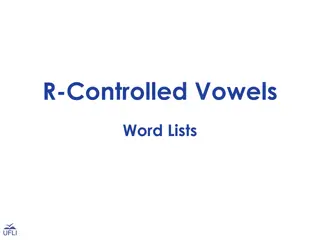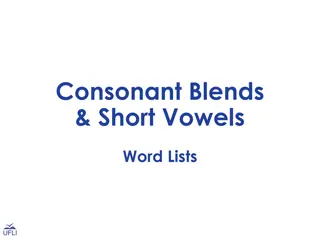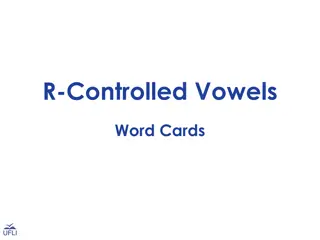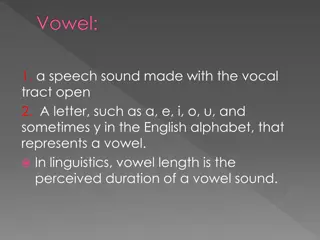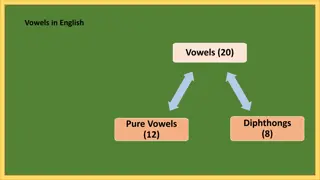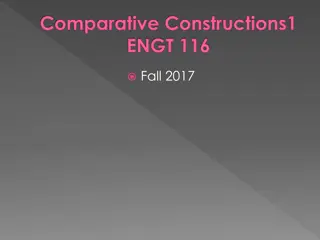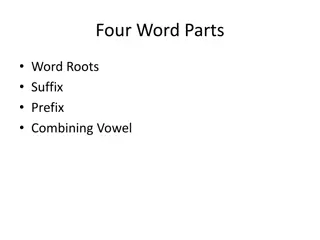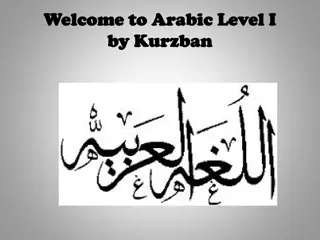
Understanding Vowel Production and Classification in English
Explore the intricacies of vowel production and classification in English, where vowels are formed with an open approximation of the articulators. Learn about the different positions of the tongue and the articulators involved in creating front, back, and central vowels. Discover the distinctions between rounded and unrounded vowels based on the shape of the mouth. Dive into the 12 pure vowels present in the English language and understand how the tongue movements contribute to the phonetic transmission of various words.
Download Presentation

Please find below an Image/Link to download the presentation.
The content on the website is provided AS IS for your information and personal use only. It may not be sold, licensed, or shared on other websites without obtaining consent from the author. If you encounter any issues during the download, it is possible that the publisher has removed the file from their server.
You are allowed to download the files provided on this website for personal or commercial use, subject to the condition that they are used lawfully. All files are the property of their respective owners.
The content on the website is provided AS IS for your information and personal use only. It may not be sold, licensed, or shared on other websites without obtaining consent from the author.
E N D
Presentation Transcript
Vowels are made with an open approximation of the articulators. The active articulator which is always the front, the back or the centre of the tongue, is raised towards the passive articulator which is either the hard palate or the soft palate or the meeting point between the hard and the soft palates. As a result, there is a sufficient gap between the two articulators for the air to escape through the mouth without any friction. The quality of the vowel depends on the shape of the mouth and position of the tongue.
The tongue assumes a number of different positions to produce different vowel sounds but the upper surface of the tongue is usually convex [ ]. This is because some part of the tongue i.e. the front, the centre or the back is raised towards the roof of the mouth. In English there are 12 pure vowels.
In English there are 12 pure vowels. I) Classification of Vowels According to the Part of the Tongue Raised Towards the Palate:
1. Front Vowels: In the production of front vowels, the front of the tongue is raised in the direction of hard palate. e.g. / i:, , e, / e.g. Phonetic Transmission of Words having front vowels: these - / z/, bit - /b t/, bread - / bred/, lamp - /l mp/
2. Back Vowels: In the production of back vowels, the back of the tongue is raised in the direction of soft palate. e.g. / u:, , :, , :/ e.g. Phonetic Transmission of Words having back vowels: tube - /tju:b/, book - /b k/, hot - /h t /, smart - /sm :t / all - / :l/,
3. Central Vowels: In the production of central vowels, the centre of the tongue is raised in the direction of centre of palate. e.g. / , :, / e.g. Phonetic Transmission of Words having central vowels: bus - / b s /, girl - / :, l /, ajar- / d : /
II) Classification of the Vowels according to the Shape of the Lips / Mouth: 1. Rounded:Here, the lips are brought forward as for the vowel /u:/. 2. Unrounded: Corners of the lips are pulled back as for the vowel / i: /.
1. Close Vowels: In the production of close vowels the part of the tongue is raised very close to the roof of the mouth. As in /i:/ 2. Half Close Vowels: In the production of half-close vowels the part of the tongue is raised between close and open but nearer to close than open. As in / /.
3. Open Vowels: In the production of Open vowels, the part of the tongue is far away from the roof of the mouth. As in / : /. 4. Half Open Vowels: In the production of half open vowels, the part of the tongue is raised between close and open but nearer to open than close. As in / /.
Three Term Labels of English Vowel Sounds: Sr. No. Vowel 1. Part of the Tongue Raised Height of the Tongue Raised Front Close Shape of the Lips Unrounded / i: / 2. Front Half Close Unrounded / / 3. / e / Front Between Half Close and Half Open Unrounded 4. / / Front Just Below Half Open Unrounded 5. / u: / Back Close Rounded 6. Back Between Close and Half Close Rounded / / 7. Back Half Close and Half Open Rounded / : / 8. Back Open Rounded / / 9. Back Open Unrounded / : / 10. Central Between Half Close and Half Open Unrounded / / 11. /3:/ Central Between Half Close and Half Open Unrounded 12. Central Between Open and Half Open Unrounded / /


